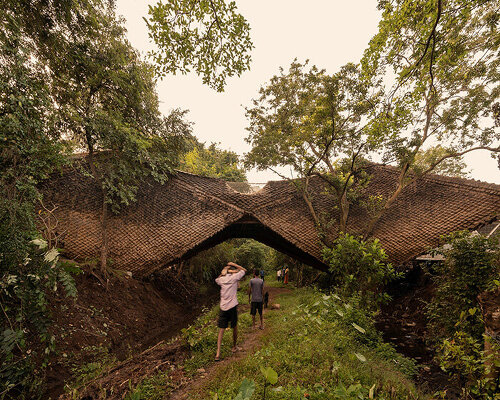a house designed as a bridge
The Bridge House by Wallmakers, led by architect Vinu Daniel, stands in Karjat, India, where a natural gorge divides the land. A natural stream has carved a seven-meter-deep channel through the site, creating both a challenge and an opportunity. The two parcels of land required a connection, yet no foundations could be placed within the 100-foot width of the spillway. As a result, the dwelling is suspended across this divide as an occupiable bridge.
The structure’s form emerged from constraint. Designed as a 100-foot suspension bridge composed of four hyperbolic parabolas, it uses minimal steel pipes and tendons for tensile strength, while a thatch-mud composite provides compressive resistance. The dialogue between these materials lends a structure that is both taut and flexible.
images © Studio IKSHA
wallmakers learns from the pangolin
Set amid dense vegetation, the Bridge House is built by Wallmakers as a natural extension of its surroundings. The thatched surface — layered in overlapping scales reminiscent to the skin of a pangolin — offers thermal insulation and gentle cooling, allowing the structure to rest lightly on the site. Only four footings anchor the bridge so as to minimize disturbance to the terrain and preserving the contours of the gorge.
The mud plaster coating serves a practical purpose as much as an aesthetic one. It prevents pests from entering the thatch and fortifies the shell against compression, maintaining the stability of the bridge without the need for vertical suspension pillars. What results is a dwelling that blends technical efficiency with organic tactility, forming a habitat where architecture and environment coexist without hierarchy.
Wallmakers’ Bridge House spans a natural gorge in Karjat, India
organic interiors of reclaimed ship-deck wood
Inside, Wallmakers’ Bridge House maintains a measured openness. The plan centers around an oculus that frames the sky and channels rain into the courtyard, turning weather into an architectural event. Light filters through the circular void and across surfaces of reclaimed timber and jute. This establishes a rhythm of shadow and air that shifts throughout the day.
The four bedrooms open toward the forest canopy or overlook the stream below. Reclaimed ship-deck wood lines the floors, while jute and mesh screens filter light and air, preserving a sense of continuity with the landscape beyond.
For Wallmakers, the Bridge House represents an ongoing inquiry into material intelligence and site-responsive construction. In Karjat’s humid and forested terrain, the project demonstrates how local resources, however limited, can be transformed into structural innovation.
four hyperbolic parabolas form a suspension bridge made from steel tendons, thatch, and mud
an oculus at the center opens interiors to the sky and rain
only four footings anchor the house to preserve the surrounding landscape
a mud plaster layer strengthens the structure and protects the thatch from pests
the thatched exterior takes cues from pangolin scales and lends thermal insulation
reclaimed ship-deck wood, jute, and mesh screens define interior finishes
project info:
name: Bridge House
architect: Wallmakers
location: Karjat, India
lead architect: Vinu Daniel | @ar.vinudaniel
design team: Preksha Shah, Ramika Gupta
completion: 2025
photography: © Studio IKSHA | @iksha.in
The post wallmakers wraps its suspended ‘bridge house’ in skin of thatched scales appeared first on designboom | architecture & design magazine.

